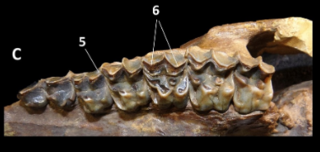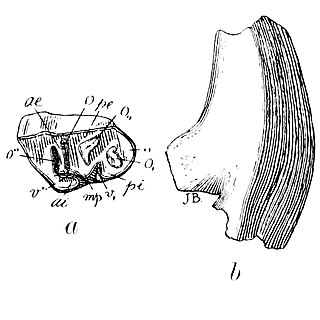
Hapalops is an extinct genus of ground sloth from the Early to Late Miocene of Brazil, Bolivia, Colombia, and Argentina in South America.

Cramauchenia is an extinct genus of litoptern South American ungulate. Cramauchenia was named by Florentino Ameghino. The name has no literal translation. Instead, it is an anagram of the name of a related genus Macrauchenia. This genus was initially discovered in the Sarmiento Formation in the Chubut Province, in Argentina, and later it was found in the Chichinales Formation in the Río Negro Province and the Cerro Bandera Formation in Neuquén, also in Argentina, in sediments assigned to the SALMA Colhuehuapian, as well as the Agua de la Piedra Formation in Mendoza, in sediments dated to the Deseadan. In 1981 Soria made C. insolita a junior synonym of C. normalis. A specimen of C. normalis was described in 2010 from Cabeza Blanca in the Sarmiento Formation, in sediments assigned to the Deseadan SALMA.
Victorlemoinea is an extinct litoptern genus of the family Sparnotheriodontidae, that lived from the Early to Middle Eocene. Fossils of Victorlemoinea have been found in the Las Flores, Sarmiento and Koluel Kaike Formations of Argentina, the Itaboraí Formation of Brazil and La Meseta Formation, Antarctica.
Proterotherium is an extinct genus of litoptern mammal of the family Proterotheriidae that lived during the Late Miocene of Argentina and Chile. Fossils of this genus have been found in the Ituzaingó Formation of Argentina, and the Galera Formation of Chile.
Megadolodus is an extinct genus of proterotheriid litopterns.
Astrapothericulus is an extinct genus of mammals, belonging to the order Astrapotheria. It lived during the Lower Miocene in what is now South America.
Polymorphis is an extinct genus of litopterns belonging to the family Macraucheniidae. It lived during the Middle Eocene of Argentina.
Adianthus is an extinct genus of litoptern that lived during the Early Miocene to the Middle Miocene in what is now Argentina and Chile.
Proadiantus(Ameghino, 1897) is an extinct genus of adianthid litoptern. It lived during the Late Oligocene, in what is today South America. It consists of only 1 species, Proadiantus excavatus.

Anisolambda is an extinct genus of litoptern. It lived from the Late Paleocene to the Middle Eocene in what is now Argentina.
Proectocion is an extinct genus of adianthid litoptern. It lived during the Early Eocene, in what is now South America.

Protheosodon is an extinct genus of proterotheriid litoptern. It lived from the Late Oligocene to the Early Miocene in what is now Argentina and Colombia.

Tetramerorhinus is an extinct genus of proterotheriid litoptern that lived during the Early and Middle Miocene in what is now Argentina and Peru.
Proadinotherium is an extinct genus of toxodontid. It lived between the Late Oligocene and the Early Miocene in what is now South America.

Argyrohippus is an extinct genus of notoungulate, belonging to the family Notohippidae. It lived from the Late Oligocene to the Early Miocene, and its fossilized remains were found in South America.

Trachytherus is an extinct genus of mesotheriid notoungulate that lived from the Late Oligocene to the Early Miocene in what is now South America.
Colpodon is an extinct genus of herbivorous mammal, belonging to the order Notoungulata. It lived during the Early Miocene, in what is today Argentina and Chile, in South America.
Patriarchus is an extinct genus of interatheriid notoungulates that lived during the Early Miocene in what is now Argentina. Fossils of this genus have been found in the Santa Cruz Formation of Argentina.

Prozaedyus is an extinct genus of chlamyphorid armadillo that lived during the Middle Oligocene and Middle Miocene in what is now South America.
Guilielmofloweria is an extinct genus of proterotheriid litoptern that lived from the Middle to Late Eocene of what is now Argentina. Fossils have been found in the Sarmiento Formation of Argentina.
















